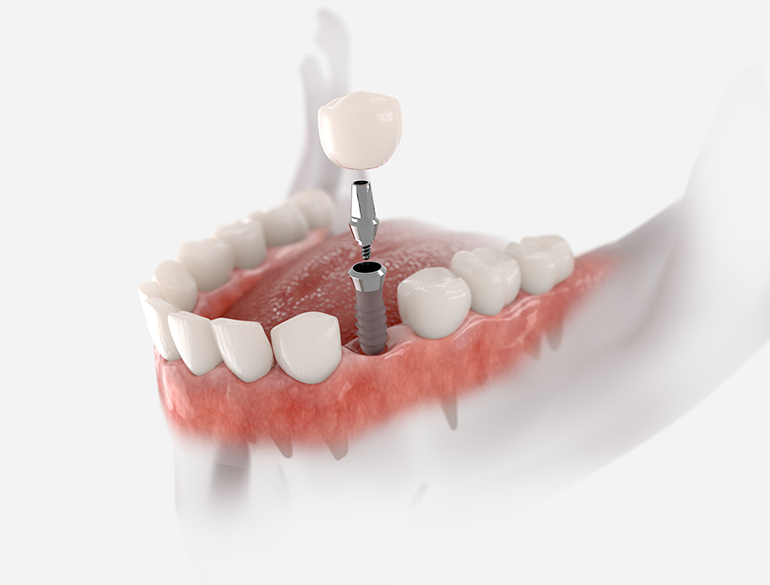What Does Dental Sense Mean?
Table of ContentsSome Ideas on Dental Sense You Need To KnowAn Unbiased View of Dental SenseThe Facts About Dental Sense RevealedDental Sense for Dummies
are clinical tools operatively dental implanted into the jaw to restore a person's capacity to eat or their appearance. They supply assistance for artificial (phony) teeth, such as crowns, bridges, or dentures. When a tooth is shed as a result of injury or condition, an individual can experience problems such as rapid bone loss, defective speech, or changes to chewing patterns that cause pain.Dental dental implant systems consist of an oral implant body and oral implant joint and may also consist of a joint fixation screw. Same day dental implants. The dental implant body is surgically placed in the jawbone instead of the tooth's origin. The oral implant abutment is usually connected to the dental implant body by the joint addiction screw and extends through gum tissues into the mouth to support the connected man-made teeth
(https://myspace.com/dentalsense1)Structure of The Dental Implant System choosing dental implants, speak to your dental copyright regarding the possible advantages and dangers, and whether you are a candidate for the procedure. Things to think about: Your overall wellness is a vital factor in identifying whether you are a good prospect for oral implants, for how long it will take to recover, and how much time the implant may remain in location.
Smoking may affect the healing procedure and reduce the long-lasting success of the dental implant. The recovery procedure for the implant body might take several months or longer, during which time you normally have a momentary abutment in location of the tooth. the dental implant procedure: Meticulously adhere to the dental health directions given to you by your dental company.
Some Known Factual Statements About Dental Sense
Implant failing can lead to the demand for an additional surgery to deal with or replace the implant system. Recovers the capability to eat Restores cosmetic look Aids keep the jawbone from diminishing as a result of bone loss Preserves the health and wellness of the bordering bone and gums Assists maintain surrounding (nearby) teeth stable Boosts quality of life Damage to surrounding natural teeth throughout dental implant placement Injury to the surrounding cells throughout surgical procedure, such as sinus perforation Injury throughout surgical procedure (for instance, fracture of bordering jawbone) Insufficient feature, such as really feeling like the teeth do not attack together generally A sensation that the tooth is loose or twisting in area resulting from an abutment screw loosening Implant body failing (looseness of the implant body) due to systemic infection, which may be more probable in people with unrestrained diabetes mellitus due to local infection in bone and gums supporting the implant body because of delayed healing, which may be much more likely in people that smoke Trouble cleaning up the gum tissues around the dental implant, leading to bad dental health Untreated gum condition Post-surgical numbness due to nerve impingement or damage Constantly notify health treatment suppliers and imaging professionals that you have dental implants before any type of magnetic resonance imaging (MRI) or x-ray procedures.
FDA is not knowledgeable about any kind of damaging events reported for MRI or x-ray treatments with dental implants. Oral implants systems are usually made of materials that adhere to global consensus standards of the International Company for Standardization (ISO) or ASTM International. These criteria have information of what makes a risk-free product.

An oral implant is a structure that replaces a missing tooth. With screw-like devices, the specialist inserts an implant into the jawbone, and it acts as a support for a fabricated tooth, called a crown.
Dental Sense - An Overview
Some individuals are not eligible for dental implant surgical treatment. It is for dental doctors to run on people with: severe illnessuncontrollable metabolic diseasebone or soft cells illness or infectionIf these issues are dealt with, a person can have the surgical procedure. In, oral surgeons avoid running on individuals with: If individuals with any of the above undertake oral implant surgical procedure, there is a greater risk of the dental implant stopping working.

Dental implant surgical procedure is a tailored process. Give you time to heal. Attach the post and final crown, bridge or denture.
Next off, your specialist will meticulously place the dental implant into your jaw. Ultimately, your cosmetic surgeon will reposition your gum tissues and shut the laceration with stitches. If your implant is near the front of your mouth, your dental practitioner will certainly make a momentary tooth for you to put on until you heal. By doing this, you won't have a gap in your smile while you recover.
The Greatest Guide To Dental Sense
Your supplier can tell you what to anticipate in your circumstance. Throughout the healing stage, your jawbone should fuse to the oral implant. This procedure, called osseointegration, is essential for stability and lasting success. This process can take anywhere from three to 9 months. Sometimes, it might take much longer.
As soon as your implant heals, your dental expert can connect the joint (small adapter blog post) and your final reconstruction (crown, bridge or denture). This generally takes about one hour to finish and might require a 2nd minor surgical procedure. You shouldn't really feel any discomfort throughout your oral implant procedure due to the fact that your service provider will certainly make use of medication to numb your gum tissues.